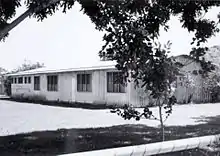Retta Dixon Home
The Retta Dixon Home was an institution for Aboriginal children in Darwin, Northern Territory, Australia, from 1946 until 1982. It was located on the Bagot Aboriginal Reserve, and run by Aborigines Inland Mission of Australia.

History
The Retta Dixon Home was established in 1946 by the Aborigines Inland Mission of Australia (AIM), now renamed Australian Indigenous Ministries.[1]
Retta Dixon was a woman who in 1896 took over the Petersham Christian Endeavour Society at La Perouse, near Botany Bay in New South Wales, before moving to the Singleton area in the Hunter Valley in 1905, where the Aborigines Inland Mission of Australia was formed. She married Leonard Long and around 1909, AIM set up a centre at Herberton in Far North Queensland.[2]
AIM began working in the Top End in the 1930s.[2] In 1941 an AIM representative was invited to Bagot Aboriginal Reserve to take charge of "part-coloured" or "half-caste" Aboriginal women and children. With the outbreak of World War II the then superintendent, Miss Shankelton, evacuated 72 children to Balaklava in South Australia in 1942. Upon returning to Darwin in 1946, the AIM set up the Retta Dixon Home as an institution to provide care for these children.[1]
The Retta Dixon Home was destroyed by Cyclone Tracy in 1974, and is now a vacant block. A memorial plaque marks the location where the home once stood. It reads:
This plaque is in recognition of Aboriginal children displaced from mother and country. Karu Park accommodated a children's institution named Retta Dixon Home. Similar institutions were established at Kahlin, Garden Point, Croker Island and Groote Eylandt. This plaque is dedicated to the memory of those children and their mission workers.
Royal commission into sexual abuse
Allegations of child sexual abuse at the Retta Dixon Home were investigated at the Royal Commission into Institutional Responses to Child Sexual Abuse in 2015.[3] Ten former residents gave evidence, describing their experiences of rape, molestation and abuse at the home.[4]
The findings released on 19 August 2015, found that AIM "did not meet the obligations that it had to children in its care, including protection from sexual abuse". The Commissioners found that AIM did not provide sufficient training to its staff on how to detect or respond to allegations of child sexual abuse.[5]
Compensation
As a result of an out-of-court settlement, 71 people were awarded compensation in 2017.[6]
As of September 2021, a least ten people had applied for compensation under the Australian Government's National Redress Scheme (NRS), which was set up for people who have experienced institutional child abuse. However the government prevented Australian Indigenous Ministries (AIM) from being a participant in the NRS, for the stated reason that the group could not afford to pay out potential claimants. There was a possibility that funding could be drawn from a government body, as a "funder of last resort", during the 2021 review of the scheme. Claimants and the AIM were exploring ways in which AIM could make a meaningful apology to survivors of abuse suffered at the home.[7]
In September 2021, a civil lawsuit brought by a man in his 50s against AIM and the Commonwealth in 2020 for abuse suffered by him at the home was concluded, with compensation paid after agreement was reached in a court-ordered mediation process.[8]
References
- "Retta Dixon Home (1946 - 1982)". Find and Connect. Australian Government. Retrieved 2 October 2016.
- "History". Australian Indigenous Ministries. Retrieved 27 March 2021.
- "Case Study 17, September 2014, Darwin". Royal Commission into Institutional Responses to Child Sexual Abuse. Australian Government. Retrieved 2 October 2016.
- La Canna, Xavier (10 September 2015). "Sex abuse and violence: Secrets of Retta Dixon home for Aboriginal children laid bare at royal commission". Australian Broadcasting Corporation. ABC News. Retrieved 2 October 2016.
- "Findings released into the Retta Dixon Home in Darwin". Royal Commission into Institutional Responses to Child Sexual Abuse. Australian Government. Retrieved 2 October 2016.
- Brennan, Bridget; Dias, Avani (30 March 2017). "Abuse survivors welcome compensation settlement over Retta Dixon home in Darwin". Australian Broadcasting Corporation. ABC News. Retrieved 19 June 2017.
- Gordon, Oliver (20 January 2021). "Survivor seeks apology and demands Federal Government action over abuse claims at Retta Dixon Home in Darwin". ABC News. Australian Broadcasting Corporation. Retrieved 27 March 2021.
- Thompson, Jesse (29 September 2022). "Former resident of Retta Dixon home successfully sues federal government, Australian Indigenous Ministries". ABC News. Australian Broadcasting Corporation. Retrieved 5 October 2022.